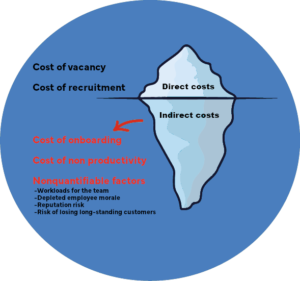
Every growing business reaches a point where the workload exceeds the available labour. More employees are needed and the search begins. Hiring, as predicted by experts, has been and continues to be a challenge – finding the right fit takes a while. You might get a clue when you look at this. More employees are needed and the search begins. Hiring, as predicted by experts, has been and continues to be a challenge – finding the right fit takes a while. You might get a clue when you look at this.
A company with consistent growth, a decent company culture, well-reasoned pay scale, looking for a project manager with an annual salary of €122,000/year. Key role expected to boost growth, allowing the company to supply to the increased demand it is facing. They have been looking for the right person for three months. It would make sense to calculate the Cost of Vacancy. The CoV is a key figure that represents the actual costs of an unfilled position in the company. It forms a useful basis for planning the recruiting budget and therefore is critical for everyone with personnel responsibility. This company is smart and leaves no loose ends, so it has calculated its CoV, like this:
€122,000 annual salary : 250 working days per year = €480/day €480 * factor 2 = €960/day. (we assume that the impact of the position on turnover would be twice its cost) €960 * 150 days (3 months looking for the right fit + notice period of 2 months when the person is found) = €144,000 is the Cost of Vacancy.
With a cost factor of 3 (without project manager, no project) you would be at €216.000 for the same period!!!
The calculation is based on the assumption that each employee contributes his or her share to the value added, i.e. to the company’s turnover, i.e. a need for employees reduces the operating result. One now takes the annual salary and divides it by the number of working days. According to a Harvard study confirmed by analysts, an employee costs one to three times his or her salary, depending on qualifications and contribution to the value chain. Another factor in the formula is the time it takes to fill the position:
Daily rate * Cost factor * Days of vacancy = CoV
Three months is an average time to fill a vacancy in the current market. Further estimated costs per hire are calculated at 4.000 Euros and even more. This includes the costs for the HR effort, as well as candidate expenses (e.g. travel expenses). It does not include the management time, the team lowering their productivity because they need to think about hiring, etc. side costs of looking for the right fit. Not having found a suitable candidate for a considerable time increases not only the cost, but the anxiety for HR, management and the teams involved. The team may consider compromising, making trade-offs in the requirements, hiring someone that is only “so-so”. If you have made a mistake in your choice because you compromised, let’s have a look at the costs. It all amounts to roughly 33% of the total employee costs, if your new hire exits the company after a short period of time. This 33% is made up of the recruitment costs mentioned above and the “CoV”, Cost of Vacancy. And you will have ~4000 Euros of costs again! And there might be even more hidden costs:

Rarely, would a company find itself hiring for one open position only. The costs add up, increasing the pressure on the company’s results.
One solution is the temporary use of external or interim resources. Of course, we would rather have a permanent, long-term solution – this can and should continue to be the goal, but we want to keep the costs low. Advantages of the external solution are:
It is, of course, only one way of looking at this challenge, but one that should rightly be considered.
Sources: